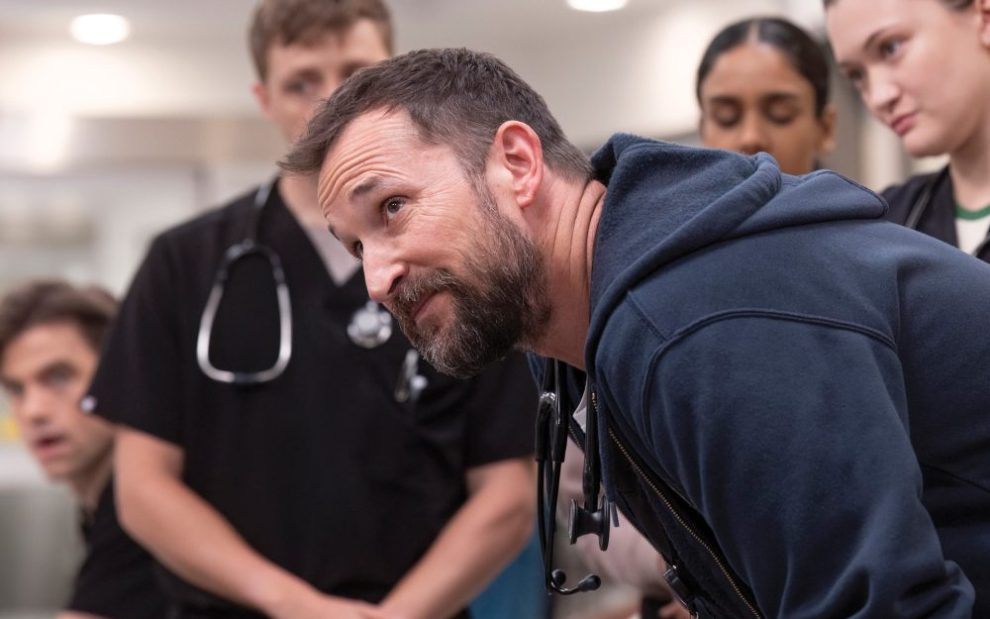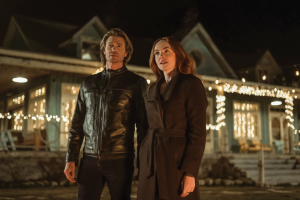This is not relaxing television.
The Pitt (Max) is a new series on an old theme—emergency department drama at a hospital. Borrowing the format of the series 24, the entire season is a single shift at Pittsburgh Trauma Medical Center; each of the 15 episodes is one hour in the emergency department on the same day.
It’s tightly written, smartly conceived, brilliantly acted, and almost too intense to watch. The pace is unrelenting. Scenes interrupt one another the way real-life crises do in a hospital. The handheld camera abandons one tragedy to follow another, sometimes never revealing the full story (like what happened to that guy who ran naked down the hall screaming, “No more needles!” or why the goofy lady in the wheelchair propositions everyone).
Doctors are pulled away from this to do that, there are close-ups of things squirting and rupturing and oozing, and the air is thick with medical jargon no one explains. Binge-watching several episodes feels like spending eight hours sitting in a packed ER, which many patients do in The Pitt.
During the first five minutes of the series, Dr. “Robby” Robinavitch (Noah Wyle) talks a physician colleague back from the rooftop ledge—literally. The cortisol levels in this joint must be off the charts.
Wyle, who picked up five Emmy nominations in the 1990s for playing Dr. John Carter in ER, is a doctor fully grown now, running his own overcrowded and underfunded emergency department. He walks with authority and compassion through the combat zone of dying patients, arguing families, bottom-line-minded administrators, and struggling staff, while battling his own PTSD from losing his mentor to COVID.
Wyle stitches together the constantly shifting scenes of barely managed chaos with calm authority. When the jumpy camera lingers on his face, war-weary layers of nuance are all too visible. Wyle shows us that Robby has seen it all and is struggling not to drown in the sea of humanity he’s trying to save.
The flashbacks to a draped and walled-off emergency room staffed by hazmat-suit-wearing doctors during the pandemic—when there wasn’t enough equipment, people, or drugs to save everyone—are chilling reminders of the tangled ethical decisions and personal sacrifices that particular catastrophe demanded from health care professionals.
These professionals, The Pitt reveals, now face an increasingly uncivil and even violent patient and family population. Nurse Evans (the accomplished Katherine LaNasa) suffers a broken nose from a patient kept waiting too long.
Taylor Dearden is a delight as young Dr. King, who has brilliant instincts and manages her frenetic first day by putting in ear buds to listen to wave sounds and watching a screen saver of a lava lamp slowly bubbling.
Some characters, however, are disappointingly formulaic: a handsome male doctor who’s a jerk, a good-hearted nurse who keeps everything and everyone afloat, a hospital administrator who cares more about profits than patients, and a mean-girl med student. We’ve seen them before, but here they’re a bit updated, dealing with modern problems: the nursing shortage, staff still recovering from pandemic heroics, and a clunky health care system strained to its breaking point.
Robby pleads with the administrator to hire more nurses and free up more beds to minimize wait times and improve patient care, but her vague responses are outdated clichés reheated from hospital shows two decades old. Why not wrestle with the very real challenges facing health care today? For starters, how insurance companies and big pharma dictate budgets, health care costs bankrupt families, and an employment-based insurance system creates inequitable care.
There are genius moments of humanity. When a patient flatlines, a passing cleaning lady stops and prays. When a 6-year-old drowning victim dies, her doctor steps out into the hall to call his own small son, just to hear the boy’s voice. When a patient dies—and they do, all the time—staff gather bedside for a silent moment to honor the dead.
When the raw sounds of a mother’s keening (heartbreakingly played by Samantha Sloyan) echo down the halls and across the nursing station, the staff and patients grow silent and hurt with her. When a teenager is declared brain dead, nurses, orderlies, and doctors line both sides of the hall for an honor walk as his body is rolled away to be used for organ transplants.
These folks are moved by what goes on around them—and they just keep on going, as best they can. Whoever first postulated that physicians and nurses were godlike, unfeeling creatures had it all wrong. The Pitt is like a war movie. This is what life is like in the trenches, why foxhole dwellers bond, how humans deal with unremitting stress.
Are these emergency department medical professionals wiser than all the rest of us? Braver? More able to deal with the messy, heartbreaking bits of life? The Pitt doesn’t tell us but suggests we should pay them more for what they do. And stop yelling at them.
The Pitt has been renewed for a second season: day two in the emergency department. I wonder if I can take it.
This article also appears in the June 2025 issue of U.S. Catholic (Vol. 90, No. 6, pages 36-37). Click here to subscribe to the magazine.
Image: Courtesy of Max













Add comment